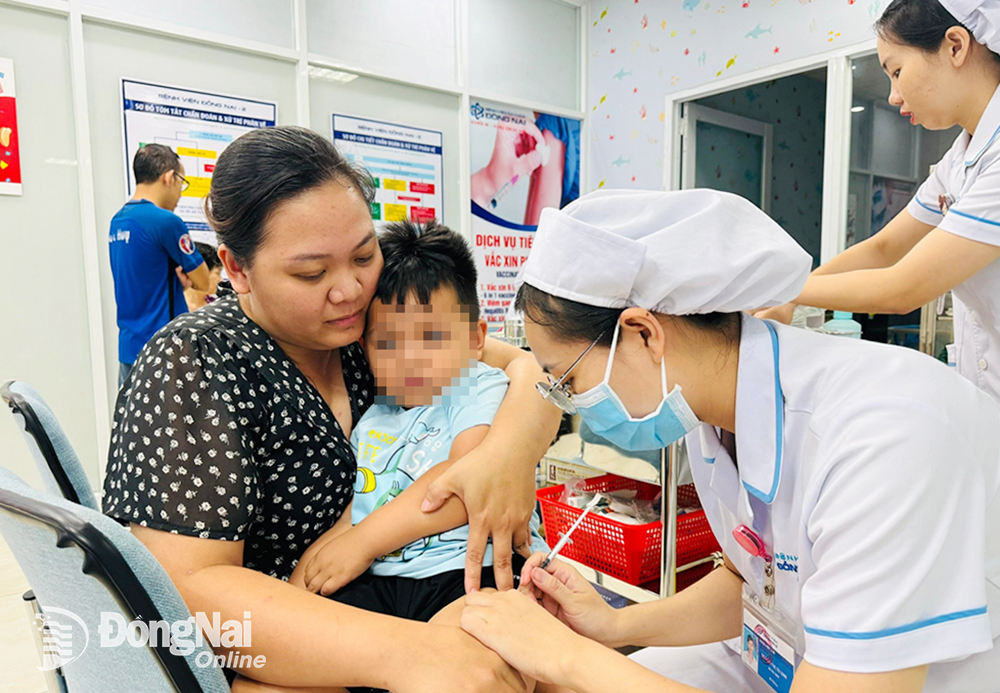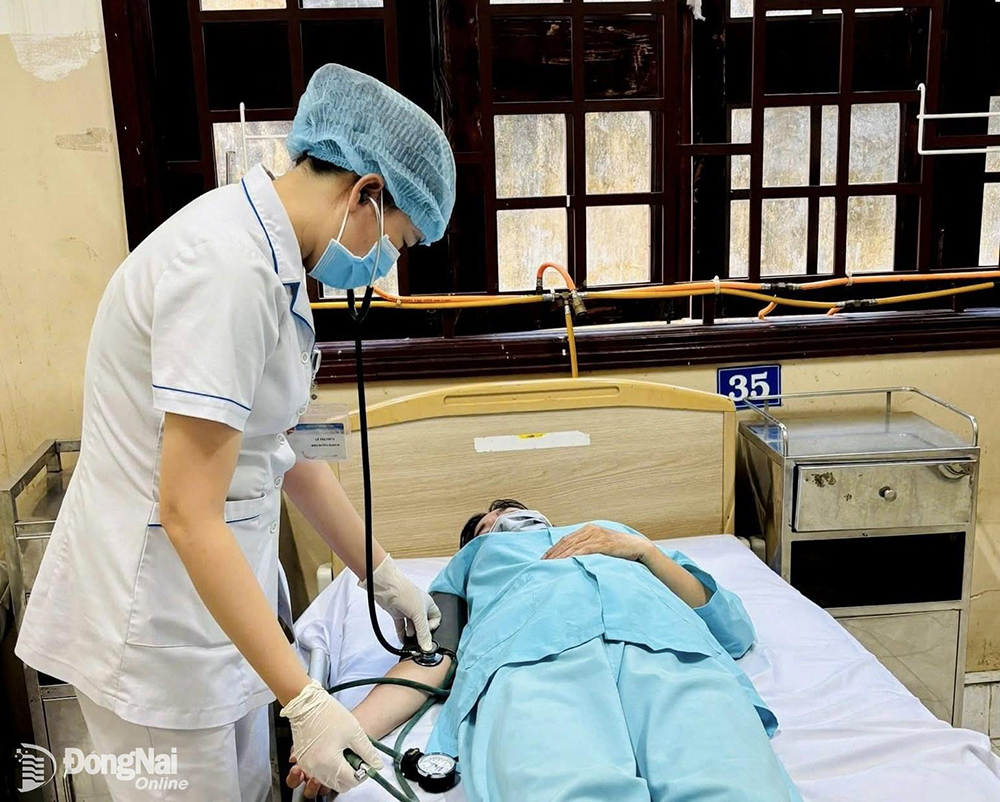Injecting meningococcal vaccine for children at Dong Nai 2 Hospital. Photo: Hanh Dung |
Meningococcal meningitis is an acute bacterial infection transmitted through the respiratory tract, commonly found in young people and has the potential to cause epidemics. The disease has a mortality rate of up to 50% if not detected and treated promptly.
dangerous disease
As reported by Dong Nai Newspaper , 3 cases of meningococcal disease were recorded in the province, including a female patient residing in Ho Nai 3 commune, Trang Bom district and 2 male patients in Tan Hoa ward, Bien Hoa city. Although there is a vaccine for meningococcal disease, the above patients have not been vaccinated. Of which, 2 cases in Tan Hoa ward are epidemiologically related to each other and have had contact with each other.
Through epidemiological investigation by the Provincial Center for Disease Control, Bien Hoa City Medical Center, Trang Bom District Medical Center, the female patient in Ho Nai 3 commune had close contact with 23 people. 2 patients in Tan Hoa ward had close contact with 43 people. These people were advised by medical staff to take antibiotics to prevent meningococcal disease. To date, no unusual symptoms have been recorded.
Meningococcal vaccine is given to children and adults from 2 months to 50 years of age. |
Specialist Doctor I Ho Thi Hoa, Head of the Department of Infectious Disease Prevention and Control, Provincial Center for Disease Control, said that meningococcal disease is transmitted through the respiratory tract, mainly through direct contact with the source of the disease by inhaling secretions from the nose, throat, and throat of people carrying the bacteria (sick people and healthy people carrying the bacteria). The possibility of disease transmission will increase if there is co-infection with respiratory viruses. Currently, in the community, 5-25% of people carry meningococcal bacteria but do not have clinical symptoms in the nose, throat, and throat. Therefore, in the near future, there may be a few more sporadic cases.
Meningococcal disease can occur at any age. However, some subjects most susceptible to meningococcal disease include: infants under one year old; adolescents and young adults; people living in crowded environments such as dormitories, boarding houses; people with prolonged malnutrition due to digestive system abnormalities or impaired intestinal absorption function...
Common symptoms of meningococcal disease include: sudden high fever of 38-39 degrees Celsius, severe headache, sore throat, runny nose, stiff neck and nape, vomiting, nausea, and body aches and pains. In addition, the patient's spirit is confused, panicked, convulsions and coma, brain dysfunction, and signs of photophobia.
The patient will develop characteristic purpura within a few hours of the onset of the disease or after a few days. The rash first appears on the legs and then spreads to the whole body. The size gradually changes from small spots to large hemorrhagic patches that cause skin peeling and necrosis.
For infants, the symptoms may not be obvious, but instead, the child will cry continuously, the body will be lethargic, reduced activity, vomiting and signs of convulsions. In that case, the child must be taken immediately to the nearest medical facility for timely examination and detection of the disease. Otherwise, it will be extremely dangerous and life-threatening.
Severe meningococcal disease can cause dangerous complications such as: sepsis, multiple organ failure, high risk of death. In addition, the disease can cause inflammation in the pericardium, urethra, lungs, conjunctiva, joints. In particular, meningococcal meningitis leaves many physical and mental sequelae, such as scars due to skin necrosis, amputation, deafness, blindness, psychological disorders, intellectual disability...
Dr. Ho Thi Hoa recommends that to prevent meningococcal meningitis, people who have not been vaccinated against meningococcal meningitis should go to medical facilities for advice and vaccination. In addition, it is necessary to keep the living and working places clean, tidy, and airy; practice good personal hygiene, wash hands regularly with soap; wear a mask when going out on the street or to crowded places; avoid contact with people who are sick or suspected of being sick.
Alarm in the Southern region
According to information from the Pasteur Institute of Ho Chi Minh City, in the first 4 months of this year, the Southern region recorded 12 cases in 8/20 provinces and cities, an increase of 9 cases compared to the same period last year. In the face of the complicated and unpredictable developments of meningococcal disease, on May 6, Dr. Nguyen Vu Thuong, Deputy Director of the Pasteur Institute of Ho Chi Minh City, chaired an online conference to monitor and prevent meningococcal disease with the Department of Health of 20 provinces in the Southern region.
Thong Nhat General Hospital has successfully treated one patient with meningococcal disease, and another patient is being monitored and treated, with good progress. Photo: Anh Hoang |
According to Dr. Nguyen Vu Thuong, all meningococcal cases recorded recently have unknown sources of infection, scattered, mainly in the Southeast region. The cases have risk factors of being concentrated in crowded, cramped places, in boarding houses with poor hygiene conditions. Of the 12 cases, 7 are between the ages of 30-40, the rest are between 1 and under 30 years old.
The leaders of the Pasteur Institute in Ho Chi Minh City predict that, with the current situation, there is a risk of discovering more new cases. Therefore, localities need to urgently implement measures to monitor, detect, and prevent disease transmission. In particular, it is necessary to step up propaganda so that people can get vaccinated against the disease. Be vigilant with patients with symptoms of meningitis, sepsis, and upper respiratory infections in medical examination and treatment facilities. Strengthen event-based surveillance and pay attention to crowded places; collect samples of all suspected cases and transfer samples for immediate testing.
In addition, localities also need to prepare medicines and chemical supplies to treat cases and provide post-exposure prophylaxis; provide professional training on diagnosis, treatment, monitoring, response, and disease prevention for medical staff.
The causative agent of meningococcal disease is the meningococcal bacteria Neisseria meningitidis. Based on the polysaccharide antigenic properties of the bacteria, meningococcal bacteria are divided into 13 serogroups, of which 6 groups: A, B, C, W-135, X and Y have the ability to cause epidemics.
Hanh Dung
Source: https://baodongnai.com.vn/xa-hoi/y-te/202505/khong-chu-quan-voi-benh-viem-mang-nao-mo-cau-d89123d/






















































![[Maritime News] More than 80% of global container shipping capacity is in the hands of MSC and major shipping alliances](https://vphoto.vietnam.vn/thumb/402x226/vietnam/resource/IMAGE/2025/7/16/6b4d586c984b4cbf8c5680352b9eaeb0)













































Comment (0)